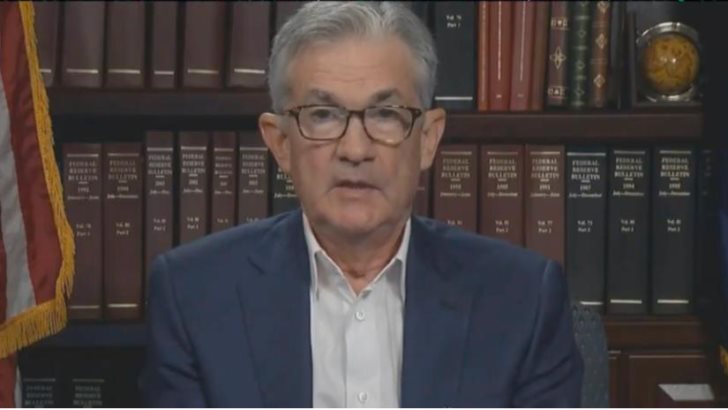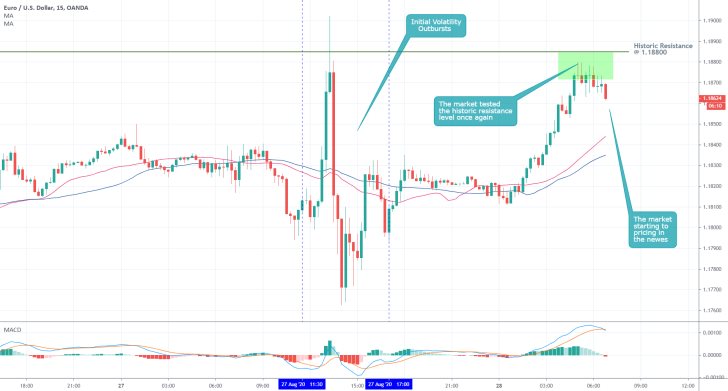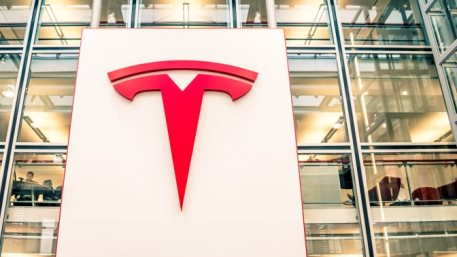
Yesterday, the highly anticipated speech of Jerome Powell at the Jackson Hole symposium unsurprisingly stirred a wave of reactions amongst economists, policymakers, investors, traders, and other market participants.
Most of the polemic following the conclusion of Mr Powell's speech was concentrated on his statements on inflation, signalling that the FED is likely to maintain near-negative interest rates for a long time before the US economy manages to recover from the impact of the coronavirus hit completely.
Powell ruffled some feathers amongst the proponents of classic economic theory by arguing that the correlation between inflation and job gains is no longer as concise as it once used to be.
Powell noted that the famous Phillips curve, which represents one of the cornerstones of modern economic theory, is flattening. Consequently, it becomes more difficult for central banks to weigh in on the impact of current economic developments when adjusting their monetary policies.
He argued that the US labour market grew markedly prior to the coronavirus-triggered slump. Even though the unemployment rate in the US was driven to a decades-long low, the inflation rate did not grow as a consequence. Instead, inflation remained below the FED's 2 per cent symmetric target rate.
The seemingly absent correlation between inflation and unemployment is worrying because it could lead to "an adverse cycle of lower inflation", which, in turn, would compel the FED to keep the Federal Funds Rate near zero indefinitely.
In such a scenario, the FED would not be able to lift the rates to stimulate economic expansion and further jobs and wage gains, which could prove detrimental for the broader economy in the longer term.
Powell went on to hint that due to the seemingly broken correlation of the Phillips curve, the Federal Reserve is now ready to use its full capacity of tools to stimulate maximum employment.
Where he departed from classic economic thought was his admission that the FED no longer needs to cut rates to stave off unwanted surges in inflation when the labour market is growing so strongly.
The market received these remarks as a strong indication that the era of low interest rates is here to stay for a long time. What Powell and his colleagues are essentially trying to achieve is two hit two birds with one stone – maintain the dovish monetary policy stance and hope for robust gains in job growth and inflation.
The market did not know how to react initially with the EURUSD seesawing as Powell was laying out his outlook. In the aftermath of his speech, the pair advanced towards the historic resistance level at 1.18800 before rebounding just below it.

Trendsharks Premium
Gold is undergoing a correction, as investors take profits to offset losses from falling stock prices, impacting their margins. However, we anticipate a renewed wave of [...]
The Swiss stock market index is mirroring its global counterparts, such as Germany 40 and US100, experiencing a sharp decline following the announcement of new [...]
We’re analyzing the weekly chart to grasp the broader market trend. Over the past three years, the US30 index has surged by 17,000 points, often resembling a nearly straight [...]
Over the past week, the DAX has experienced a sharp decline, plunging by an astonishing 3,400 points. This downward movement is not isolated, as its international counterparts, such as the UK100 and US100, are also facing significant [...]
EURUSD recently formed a double top at 1.0930, signaling a potential trend reversal, and has since begun a correction. After a 600-pip rally since early March, a pullback at this stage is both expected and healthy. Given these conditions, we are placing a [...]
Since early March, EURJPY has surged nearly 1,000 pips, providing us with several excellent trading opportunities. However, as the rally matures, many early buyers are beginning to take profits, leading to a noticeable slowdown in the uptrend. On Friday, the pair formed a [...]
The AUDJPY currency pair continues to be dominated by bullish momentum, as multiple golden cross patterns reaffirm the strength of the ongoing uptrend. Despite this, we are witnessing a much-needed [...]
The EURAUD currency pair appears to be undergoing a trend reversal, signaling a potential shift in market direction. A notable technical development is the formation of a Death Cross on the chart, a widely recognized bearish indicator that typically suggests a [...]
After securing an impressive 200-pip profit last week, the EURJPY currency pair is now undergoing a southward correction, retracing some of its recent gains. Despite this temporary pullback, the Golden Cross remains intact, reinforcing our view that the overall trend continues to be [...]
The appearance of a Golden Cross in Silver strengthens our analysis that the metal is currently in a strong uptrend, indicating further bullish momentum in the market. This technical pattern, where the short-term moving average crosses above the [...]
This trade presents a considerable level of risk and can be classified as an opportunistic move based on recent price action. The GBPUSD currency pair has experienced a substantial bullish rally, surging by nearly 500 pips in a strong upward movement. However, after this extended period of appreciation, the pair is showing signs of a potential [...]
The anticipated Death Cross on the SMI20 appears to be failing as price finds strong support at the 23% Fibonacci retracement level. After testing this area, the index has shown bullish strength, printing several large green candles, signaling an increase in [...]
A Golden Cross has just appeared on the USDJPY chart, signaling a potential bullish move. This technical pattern occurs when the 20 period moving average crosses above the 60 period moving average, a widely recognized indication of increasing [...]
After 2 months of a down trend, we finally see some indications of price recovery for Oil. The golden cross, a historic buy signal, supports this [...]
For the past month, the German DAX40 has experienced a remarkable 10% surge, reflecting strong bullish momentum. Despite ongoing market volatility and frequent pullbacks, every dip continues to attract fresh buyers, reinforcing the [...]
Oil continues its downward trajectory, despite occasional pullbacks. The overall trend remains bearish, reinforced by multiple Death Cross patterns, a classic sell signal indicating further weakness. Adding to this bearish outlook, the critical [...]
Over the past few days, gold has experienced a sharp decline of more than $100. This downturn can be attributed in part to traders securing profits to manage their margins, which are under strain due to the significant drop in major indices. Currently, gold has fallen below the [...]
The NASDAQ 100 index is showing strong bullish momentum, as evidenced by the formation of a Golden Cross on the chart. This classic buy signal occurs when the short moving average crosses above the long term moving average, suggesting that upward momentum is [...]
The EURAUD currency pair has encountered a significant resistance level, failing to break above the critical 61% Fibonacci retracement level. This suggests that bullish momentum is weakening, reinforcing the case for a potential downward move. Given this technical setup, we favor entering a [...]
The UK100 is experiencing a remarkable rally! Over the past few weeks, the British stock market index has surged nearly 800 points. Each minor dip has attracted more buyers, fueling the bullish momentum. However, since last week, we’ve observed a slight [...]




















